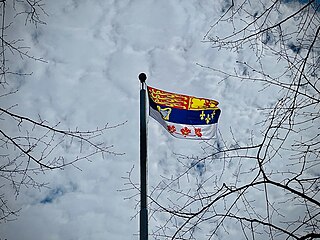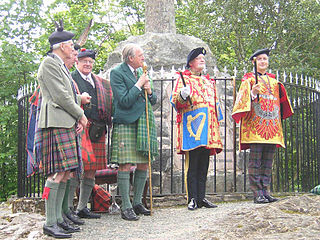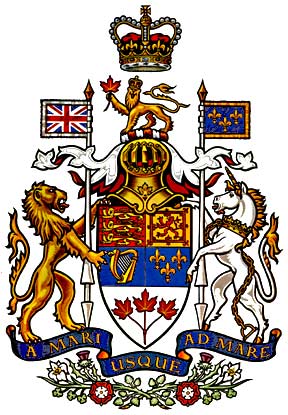
A coat of arms is a heraldic visual design on an escutcheon, surcoat, or tabard. The coat of arms on an escutcheon forms the central element of the full heraldic achievement, which in its whole consists of a shield, supporters, a crest, and a motto. A coat of arms is traditionally unique to the armiger. The term "coat of arms" itself, describing in modern times just the heraldic design, originates from the description of the entire medieval chainmail "surcoat" garment used in combat or preparation for the latter.

A tabard is a type of short coat that was commonly worn by men during the late Middle Ages and early modern period in Europe. Generally worn outdoors, the coat was either sleeveless or had short sleeves or shoulder pieces. In its more developed form it was open at the sides, and it could be worn with or without a belt. Though most were ordinary garments, often work clothes, tabards might be emblazoned on the front and back with a coat of arms (livery), and in this form they survive as the distinctive garment of officers of arms.

The coat of arms of Canada, also known as the Royal Coat of Arms of Canada or, formally, as the Arms of His Majesty The King in Right of Canada, is the arms of dominion of the Canadian monarch and, thus, also the official coat of arms of Canada. In use since 1921, it is closely modelled after the royal coat of arms of the United Kingdom, with French and distinctive Canadian elements replacing or added to those derived from the British version.

The College of Arms, or Heralds' College, is a royal corporation consisting of professional officers of arms, with jurisdiction over England, Wales, Northern Ireland and some Commonwealth realms. The heralds are appointed by the British Sovereign and are delegated authority to act on behalf of the Crown in all matters of heraldry, the granting of new coats of arms, genealogical research and the recording of pedigrees. The College is also the official body responsible for matters relating to the flying of flags on land, and it maintains the official registers of flags and other national symbols. Though a part of the Royal Household of the United Kingdom, the College is self-financed, unsupported by any public funds.

The royal standards of Canada are a set of personal flags used by members of the Canadian royal family to denote the presence of the bearer within any vehicle, building, or area within Canada or when representing Canada abroad. All are based on a banner of the coat of arms of Canada, which are the arms of the Canadian monarch.

An officer of arms is a person appointed by a sovereign or state with authority to perform one or more of the following functions:

The Canadian Heraldic Authority is part of the Canadian honours system under the Canadian monarch, whose authority is exercised by the Governor General of Canada. The authority is responsible for the creation and granting of new coats of arms, flags, and badges for Canadian citizens, government agencies, municipal, civic and other corporate bodies. The authority also registers existing armorial bearings granted by other recognized heraldic authorities, approves military badges, flags, and other insignia of the Canadian Forces, and provides information on heraldic practices. It is well known for its innovative designs, many incorporating First Nations symbolism.
The Public Register of Arms, Flags and Badges of Canada contains the heraldic emblems that have been granted, registered, approved or confirmed by the Canadian Heraldic Authority since its inception on June 4, 1988. In 2005, the Canadian Heraldic Authority began the process of creating a digital version of the register available online.

New Zealand Herald of Arms Extraordinary is an officer of arms representing the heraldic interests of New Zealand. Although affiliated with the College of Arms in London, the New Zealand Herald lives and works in New Zealand, and is not a member of the College Chapter. Since the New Zealand Herald was appointed, there have been questions as to his legitimacy and whether, as working under the authority of the College of Arms, he has any legal authority to regulate heraldry in New Zealand. The current New Zealand Herald of Arms Extraordinary is Phillip O'Shea.

The Royal Heraldry Society of Canada is a Canadian organization that promotes interest in heraldry in Canada. It was founded in 1966 and granted royal patronage in 2002.

A herald, or a herald of arms, is an officer of arms, ranking between pursuivant and king of arms. The title is commonly applied more broadly to all officers of arms.

A private officer of arms is one of the heralds and pursuivants appointed by great noble houses to handle all heraldic and genealogical questions.

The Herald Chancellor is an officer at the Canadian Heraldic Authority. The office is always filled by the Secretary to the Governor General. The Herald Chancellor is responsible for the administration of the entire vice-regal office. In some ways, the position is analogous to the Earl Marshal in England, as it is the Herald Chancellor who issues the warrants permitting the Chief Herald of Canada to make grants of arms. The Herald Chancellor also signs each completed grant document, along with the Chief Herald.
Cathy Lynne Bursey-Sabourin is a Canadian designer and heraldic artist.

Canadian royal symbols are the visual and auditory identifiers of the Canadian monarchy, including the viceroys, in the country's federal and provincial jurisdictions. These may specifically distinguish organizations that derive their authority from the Crown, establishments with royal associations, or merely be ways of expressing loyal or patriotic sentiment.

Claire Boudreau was a Canadian historian, genealogist, and officer of arms. She served as a herald in the Canadian Heraldic Authority from March 17, 1997 in the office of Saguenay Herald and later as Saint-Laurent Herald, to which office she succeeded on the retirement of Auguste Vachon, and then Deputy Chief Herald from December 1, 2005 until June 16, 2007, when she was made the second Chief Herald of Canada following the retirement of Robert Watt. She was also a nationally and internationally recognized scholar in heraldic studies. She was the author of many articles and publications. She was the principal designer and administrator of the authority's pioneering online Public Register of Arms, Flags and Badges of Canada, which was unveiled in July 2005. She was made an Academician of the Académie Internationale d'Héraldique in 2000. On May 20, 2020, Boudreau was appointed Margaree-Chéticamp herald emeritus and succeeded as Chief Herald of Canada by Samy Khalid.

Canadian heraldry is the cultural tradition and style of coats of arms and other heraldic achievements in both modern and historic Canada. It includes national, provincial, and civic arms, noble and personal arms, ecclesiastical heraldry, heraldic displays as corporate logos, and Canadian blazonry.

David Ralph Spence is a Canadian retired Anglican bishop.
Samy Khalid is a Canadian historian and herald who currently serves as Chief Herald of Canada.

The following is an armorial of the thirty individuals, who have served as governor general of Canada since Confederation.
















